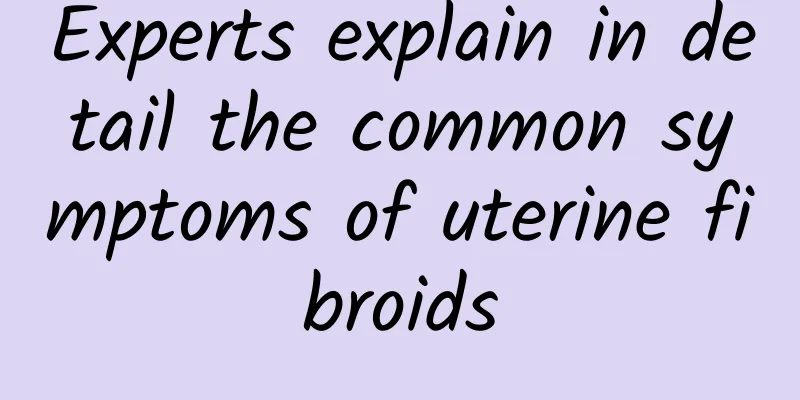Learn about some common symptoms of irregular menstruation

|
Irregular menstruation is a common gynecological disease. For most patients, they do not understand the symptoms of irregular menstruation and fail to discover the disease in time. Because they do not know the symptoms of irregular menstruation, they miss the best time for treatment. Let’s take a look at the symptoms of irregular menstruation. 1. Early menstruation. Symptoms of irregular menstruation are mainly early menstruation, which means that the menstrual cycle is normal, but suddenly shortened, shorter than 21 days, and it occurs for more than 2 consecutive cycles, but the menstrual volume is normal. It belongs to ovulatory functional uterine bleeding with biphasic basal body temperature, short follicular phase, only 7 to 8 days, or luteal phase shorter than 10 days, or body temperature rise less than 0.5℃. 2. Delayed menstruation: Normal menstruation is delayed for more than 7 days, or even 40-50 days, and occurs for more than two consecutive menstrual cycles, but the menstrual volume is normal. Among the symptoms of irregular menstruation, those who ovulate have a biphasic basal body temperature, but the follicular phase is long and the high temperature phase is low; those who do not ovulate have a monophasic basal body temperature. 3. Prolonged menstruation. The menstrual cycle is normal, the menstrual flow is normal, but the menstrual period is prolonged, the menstrual period exceeds 7 days, and even lasts for 2 weeks. Those with inflammation usually have lower abdominal pain, which is aggravated during menstruation. Usually, the amount of leucorrhea is heavy, yellow or yellow-white, thick, and has a smell. The symptoms of irregular menstruation mainly include heavy menstrual flow in those with incomplete corpus luteum atrophy; a small amount of continuous vaginal bleeding after the normal menstrual period in those with prolonged endometrial repair. 4. Menstrual disorders: irregular menstruation, early or delayed menstruation, and a cycle shorter than 21 days or longer than 35 days. 5. Intermenstrual bleeding (also known as intermenstrual bleeding or ovulation bleeding) refers to bleeding that occurs between two regular menstrual cycles. It is caused by a temporary drop in estrogen levels, which causes the endometrium to lose hormonal support and leads to endometrial shedding. The above is an introduction to the symptoms of irregular menstruation. I hope it can help you analyze them one by one. In fact, the purpose of the experts introducing the symptoms of irregular menstruation here today is to allow patients to discover the existence of the disease as early as possible, and to receive timely treatment after understanding the symptoms of irregular menstruation. Don’t miss the best treatment time. Finally, I wish you a speedy recovery. |
<<: What are the main manifestations of prevention of cervical hypertrophy?
>>: Four key points in the clinical manifestations of irregular menstruation
Recommend
What may be the cause of ovarian cysts?
The cause of ovarian cysts has always been a hot ...
5 minutes a day to easily get a six-pack (Part 1)
How strange! Many people have slender and well-pr...
Experts explain the precautions for fumigation treatment of chronic pelvic inflammatory disease
Fumigation is currently a common method for treat...
Eating winter melon helps metabolism and weight loss. Two ingredients are treasures
Most people’s first impression of the benefits of...
What are the causes of irregular menstruation? How can women regulate irregular menstruation?
Irregular menstruation in women can be caused by ...
Doctors do not recommend taking a shower directly after an abortion. There are two things you should pay attention to when taking a shower after an abortion.
You cannot take a shower immediately after an abo...
What happens if there are blood clots during menstruation?
What happens if there are blood clots during mens...
There is a reason why it is easy to gain weight! To boost your metabolism, drink the right coffee, chocolate and this soup.
"Foods that increase basal metabolism" ...
How to improve female ovarian function?
The ovary is the most important organ in a woman&...
Will threatened abortion lead to fetal malformation?
Pregnancy preservation for threatened abortion us...
Is it difficult to get pregnant with adenomyosis? Will it cause infertility?
It is difficult to get pregnant with adenomyosis....
Are pelvic effusion and pelvic inflammatory disease the same thing? They are not the same thing.
Pelvic effusion and pelvic inflammatory disease a...
How are cervical warts generally transmitted?
Cervical warts are a sexually transmitted disease...
Can I have a baby if I have Bartholin's glanditis?
Can you get pregnant and have a baby if you have ...
Is dysmenorrhea the same as adenomyosis?
As women's life pressure increases, the proba...









